The Littlewood Treaty, The True English Text of the Treaty of Waitangi, Found
Chapter: Précis 1 2 3 4 5a, 5b, 5c, 5d, 5e 6 7 8 9 10 11 12 13 14 15 16 17 18 19 20 Lord Normanby's Brief Additional Resources
Chapter 11
CLENDON’S DESPATCH NO. 6 TO THE U.S. SECRETARY OF STATE ON THE 20th OF FEBRUARY 1840
After the Treaty of Waitangi became a reality by the adherence of the chiefs who affixed their signatures to the Maori version parchment document, Clendon had a duty to inform his superiors about a British colony in progress in New Zealand. In order to make up a complete despatch he needed documents that clearly portrayed all that was happening in an official sense. The opportunity to assemble the required, relevant materials for such a despatch availed itself after the 17th of February 1840, when C.M.S. Mission printer, William Colenso, produced 200 printed copies of the official Maori text of the treaty.
We know that government officials, and probably Hobson himself, visited Clendon on the 17th of February 1840. On this day Clendon signed the Treaty of Waitangi parchment in behalf of Chief Pomaré II and then affixed his own signature beside that of the chief. The treaty parchment, also bearing 78 recent signatures from the chiefs of the Hokianga and due to be taken to Thames within the following week, was kept safe by Hobson’s government. It would seem likely that it was on this occasion that Clendon was given newly printed Tiriti O Waitangi sheets, fresh off the C.M.S. Mission press that day. Had an official English text been printed also, this would have been an opportune time to acquire it.
The section on the Treaty of Waitangi where James Reddy Clendon signed in behalf of his friend, Chief Pomaré II. Clendon wrote: Feby. 17th, 1840. Pomaré signature. James R Clendon.
Clendon, probably, already had in his possession copies of
two printed Proclamations, which Hobson had read at Kororareka Church on
the 30th of January 1840. These spelled out the intricacies of British intent
in the region and described Hobson’s commission from Queen Victoria.
To these documents Clendon was now able to add the official Maori text of
the compact or contract that the chiefs had entered into with the Crown.
It seems to have been Clendon’s expectation that an official English
version of the treaty would be produced for general circulation by Hobson’s
government. No such document was ever made and the printed Maori text remains,
to this day, the only official treaty document that was ever published.
In lieu of such a document in English being printed simultaneously to the
Maori text, Clendon was obliged to draw upon his earlier, personal transcript
or notes in order to forward a very representative English version of the
treaty to the United States. Historian, Ian Wards, supported the view that
Clendon was integral to the drafting incentive.
We know that Hobson was very anxious to get away to Thames in the Waitemata without delay and expected to go just as soon as the steady E.S.E. wind abated sufficiently to allow H.M.S Herald to leave the harbour. It seems likely that he was in attendance to meet with Pomaré II, but did not bring the final English draft with him, as it was not needed.
Clendon had to exercise the caution his responsible post demanded.
He had been a participant at the drafting session and knew the wording of
the text up until that point of development when he had last seen and transcribed
it on the 4th of February 1840.
But the English treaty text was in a constant state of metamorphosis and
was being reviewed for many hours beyond the time Clendon had sat in on
its creation. Perhaps Reverend Henry Williams found this or that wording
too cumbersome to convey in the Maori tongue and had asked for a modification
of the English text? Clendon could not know this, and yet it was his responsibility
to send the official English text, such that it could be placed within the
files of the United States government or could be printed in official gazette
notices.
We can safely state that, for one reason or another, Clendon
was unable to get the final English text from Hobson on the 17th of February,
but would await Hobson’s return from Thames and then acquire it. Clendon
was, therefore, obliged to call his personal notes from February 4th 1840
a close ‘translation’ until such time as an English text,
declared “official”, was secured from Lieutenant Governor Hobson.
Now that Clendon knew the date when a treaty was secured, he could add that
to his transcript. His records from the last treaty drafting session would
indicate, with considerable clarity, what the Treaty of Waitangi said and
meant in both languages.
It is at this later interval, beyond February 17th 1840, that Dr. Phil Parkinson
now maintains the Littlewood Treaty was created, by Busby, as a “back-translation”
from the Maori text, at the request of Clendon.
Dr Parkinson has mildly rebuked my approach to arriving at some facts as ‘injudicious reliance on that flawed syllogism "Potuit, docuit, ergo fuit" (It could be so, it ought to be so, therefore it is so)’. By the same yardstick, it will be interesting to see what facts Dr. Parkinson and his colleagues can produce, which are not based upon wishful thinking and pure supposition, to prove that the author of the Littlewood Treaty document did not intend to write that 4th of February 1840 date at the end of the text.
Dr. Parkinson and others are inferring that James Busby, the historically recognised author or acting, temporary secretary, who penned the final English draft, made a major blunder when he wrote the 4th of February 1840. Both Dr. Parkinson and his colleague, Dr. Claudia Orange, are suggesting that Busby had forgotten, less than two weeks after the momentous and memorable treaty assembly at Waitangi, involving over one thousand participants and spectators, that the signing proceedings had occurred on the 6th of February.
Somehow, according to logic proffered or embraced by our historians, Busby now, or in a momentary lapse of concentration, thought that the most spectacular and colourful two-day event ever witnessed in New Zealand had drawn to a successful conclusion on the 4th of February. More than anyone, Busby had the date of the proceedings firmly fixed in his mind, as he was the author of the original invitations sent out to the chiefs. A back-translation of his letter to Tamati Waka Néné, which was the general letter format to all of the invited chiefs, says:
‘Of the thirtieth day of January, 1840.
My Dear Friend,
Here again is mine to you. It is that a ship of war has now arrived with
a Chief on board, who is from the Queen of England, to be a Governor for
us. Now he desires that there shall be assembled together all the Chiefs
of the Confederation of New Zealand on Wednesday [February 5th] of next
holy week, so that they may see him. I therefore say unto you, friend, that
you come here to Waitangi, to my home here, to this gathering. For you yourself
are a Chief of that Confederation.
That is all, mine ends.
From me, your dear friend,
Busby.’
Staying utterly flexible on this point, would it even matter if the document was written by Busby on the 4th of February or by Busby, reproducing an exact copy of the final draft, on or just after the 17th of February? Busby wrote the final English draft, so knew both its content and the day it was produced.
- Why would Busby need to, clumsily, provide Clendon with a “back-translation” from the Maori treaty text when he was in possession of, or fully conversant with, the final English draft wording?
- Why would Clendon need Busby to do a back-translation from the Maori anyway, when Clendon had been in the country longer than Busby and, undoubtedly, spoke Maori equally as well or better?
The hypothesis that the Littlewood Treaty first originated two weeks after its recorded date, is historically unsustainable. It almost smacks of a certain desperation to destroy the innate credibility of the Littlewood Treaty document at any cost by conjuring up improbable scenarios to counter the fact that it was written on the 4th of February 1840.
We know that Clendon, on the 20th of February 1840, did not have in his possession anything that he could categorically state was the “official” English text. He had his own transcript (notes) of something he could reasonably guarantee was very close to the finalised draft wording, but the best he could do, at that moment in time, was to call it a ‘translation’ and a reasonably accurate portrayal of what the Maori text said.
In qualifying his position, Clendon wrote the following to
U.S. Secretary of State, John Forsyth:
‘This Translation is from the Native Document and is not a copy
of the Official Document in English from which the Native One is made -
and although the words may be different from what they were in the original
I think the sense is much the same - but on the return of Capt. Hobson from
the Southward I shall apply officially to him for a copy and translation
of the Treaty for the purpose of sending it to the Government of the United
States.’
Here’s what Clendon sent in despatch no. 6 to the U.S.A. on February 20th 1840:
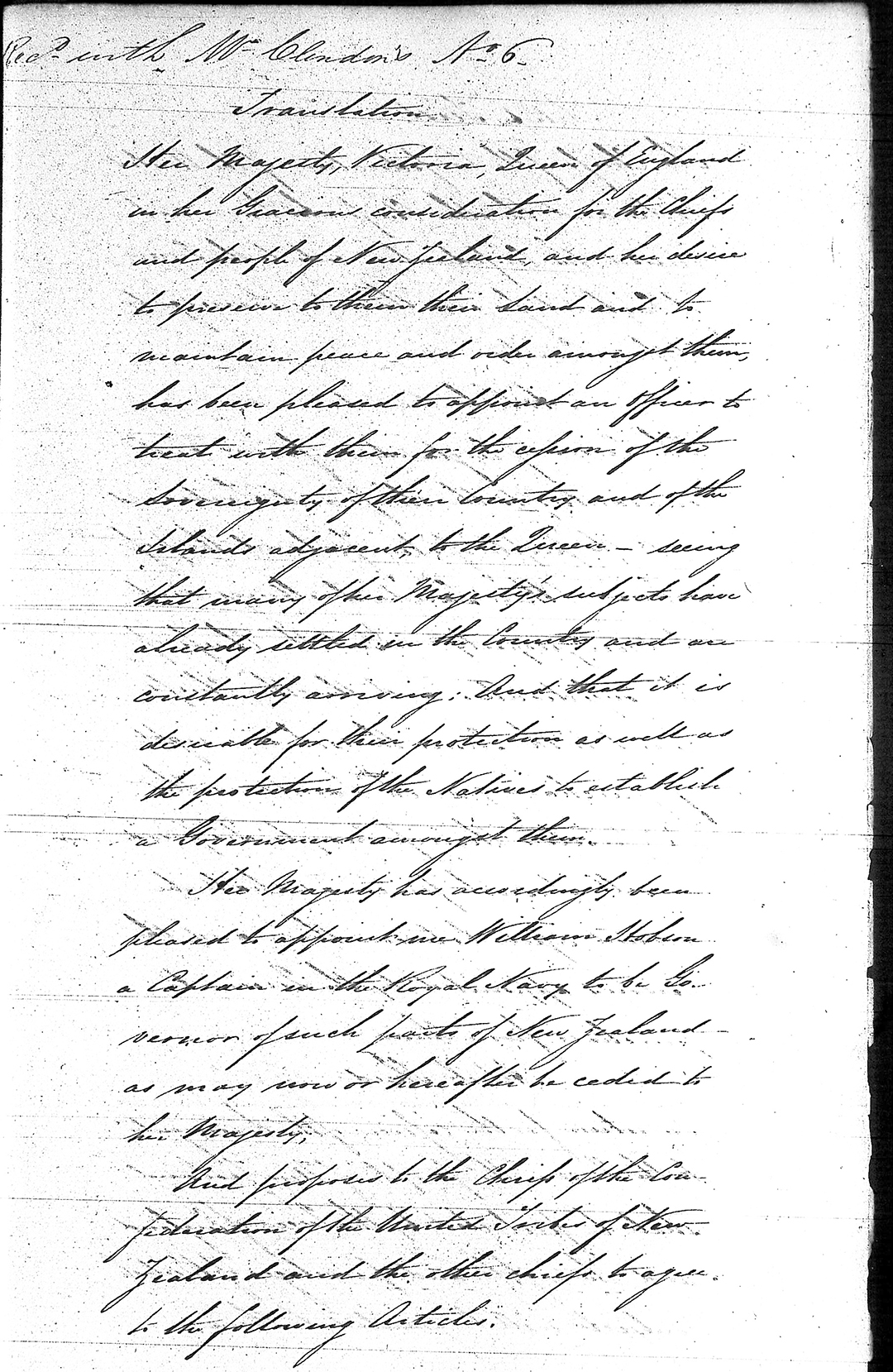
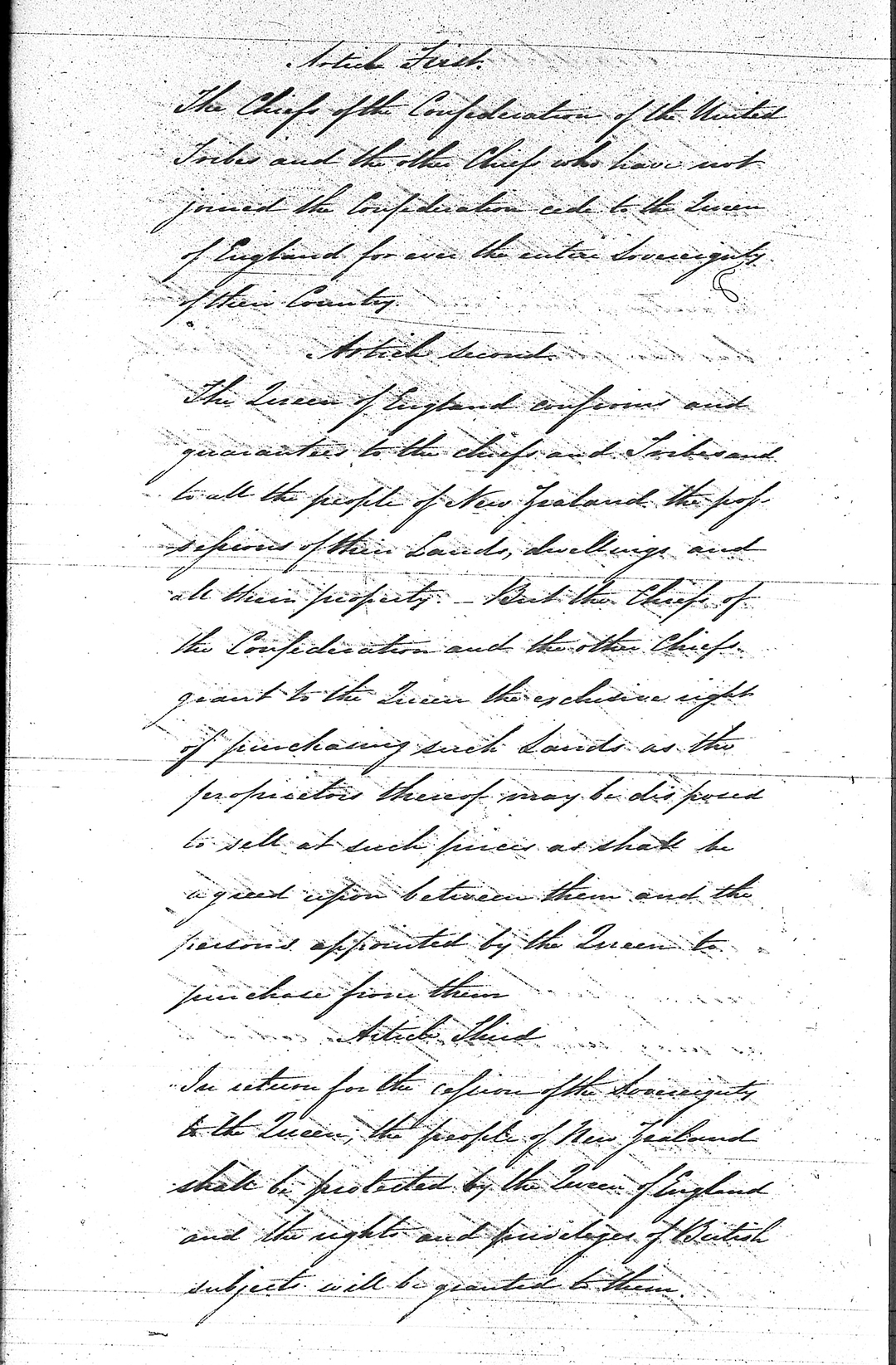
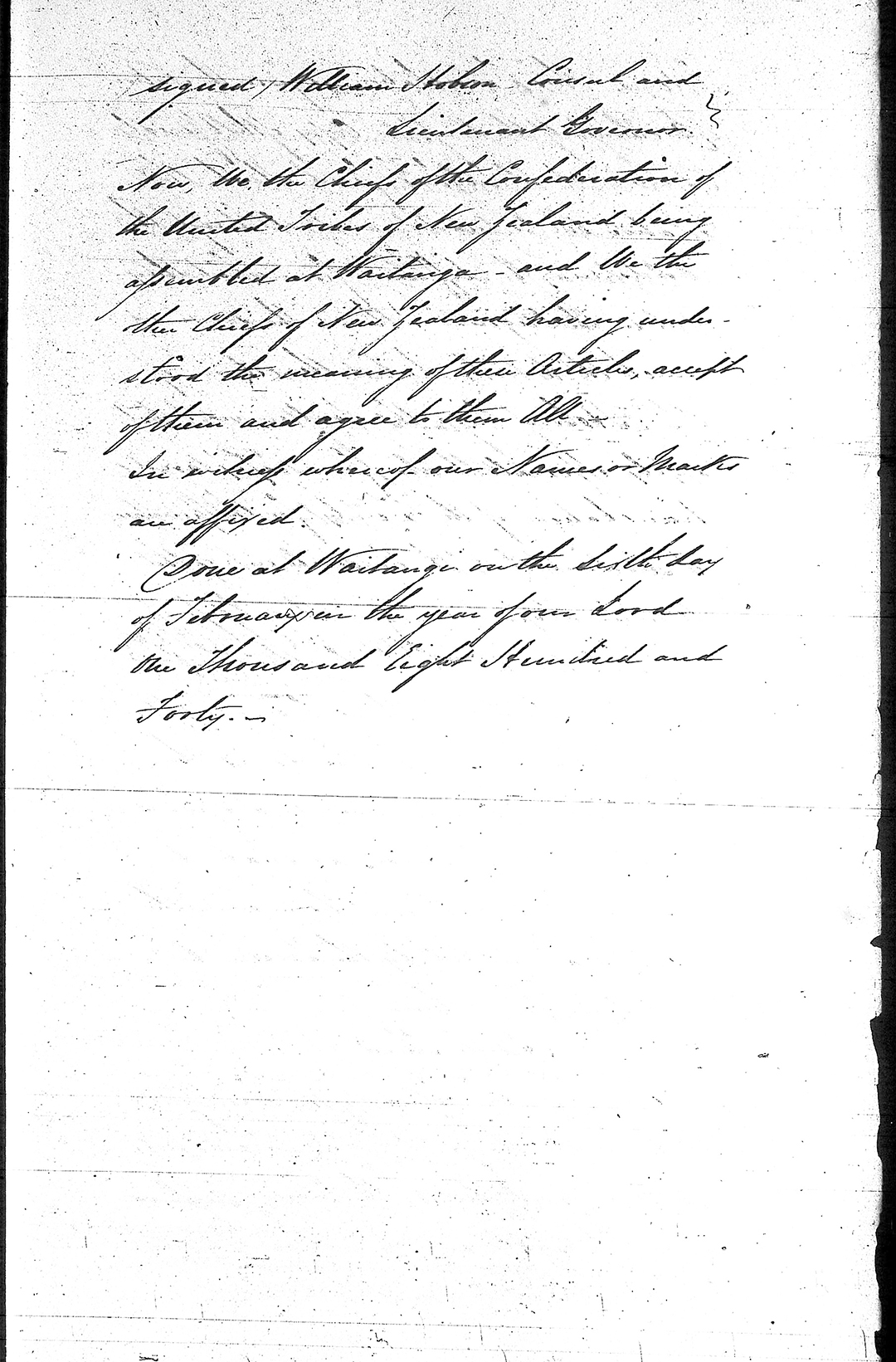
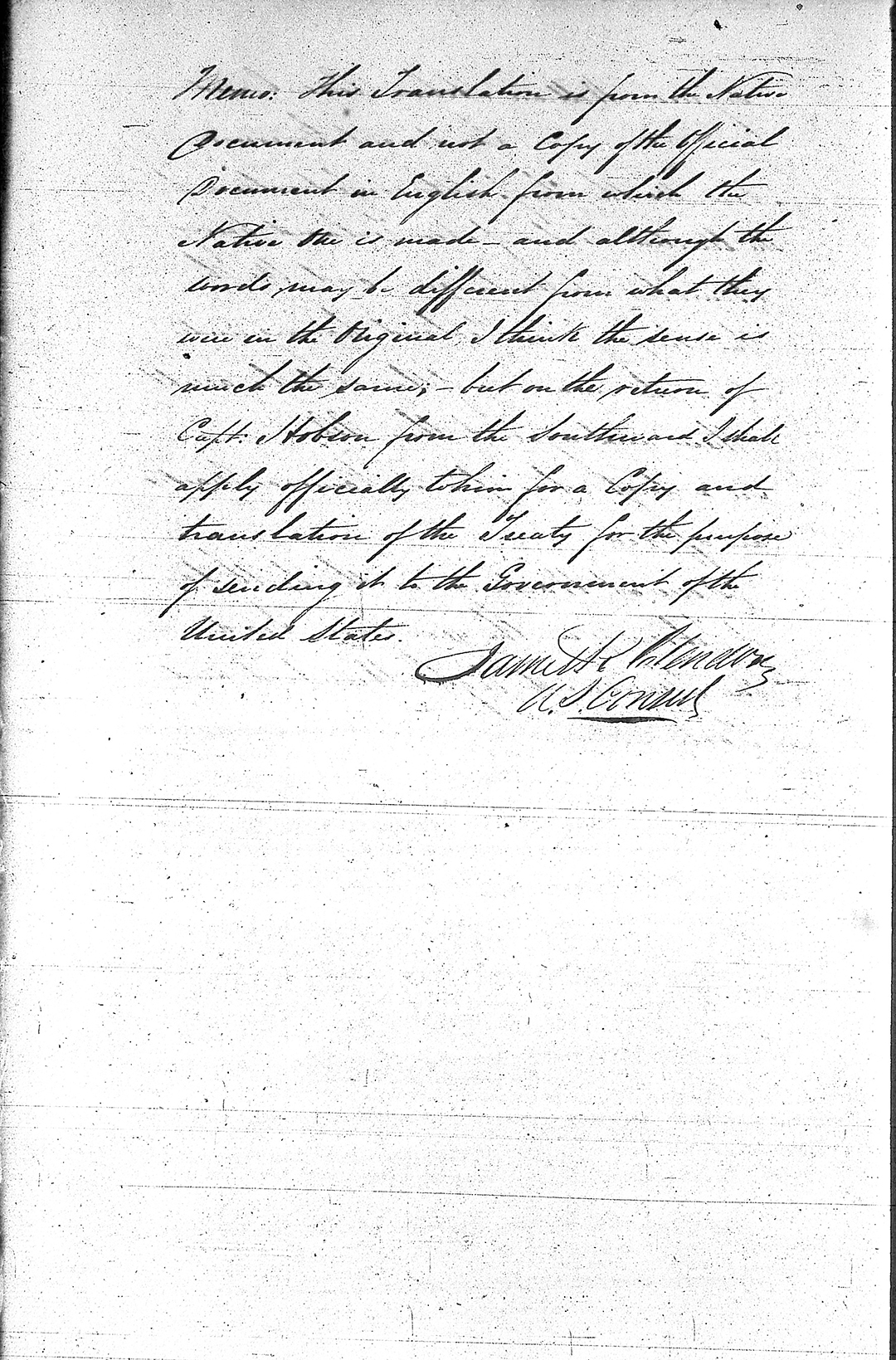
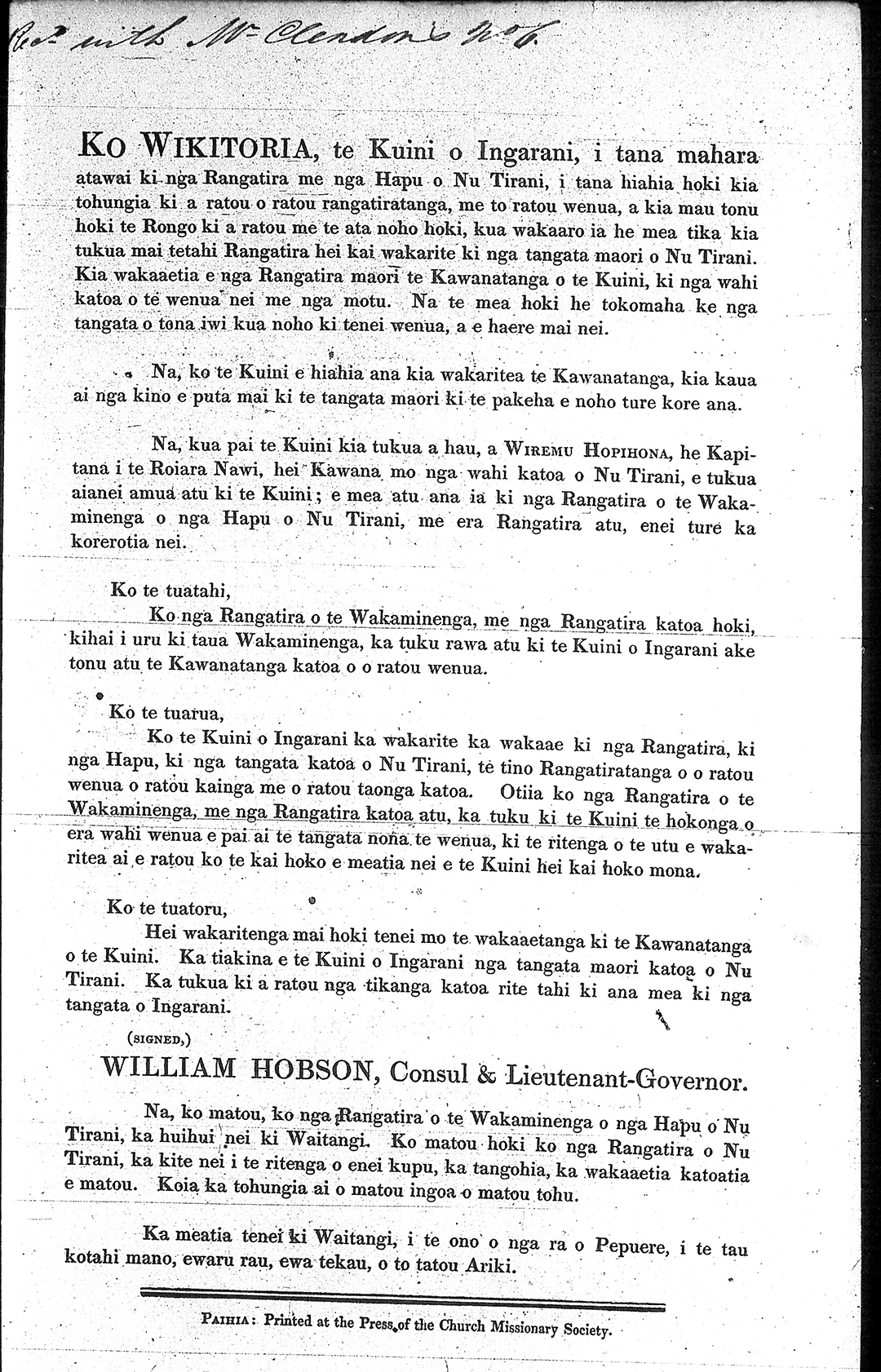
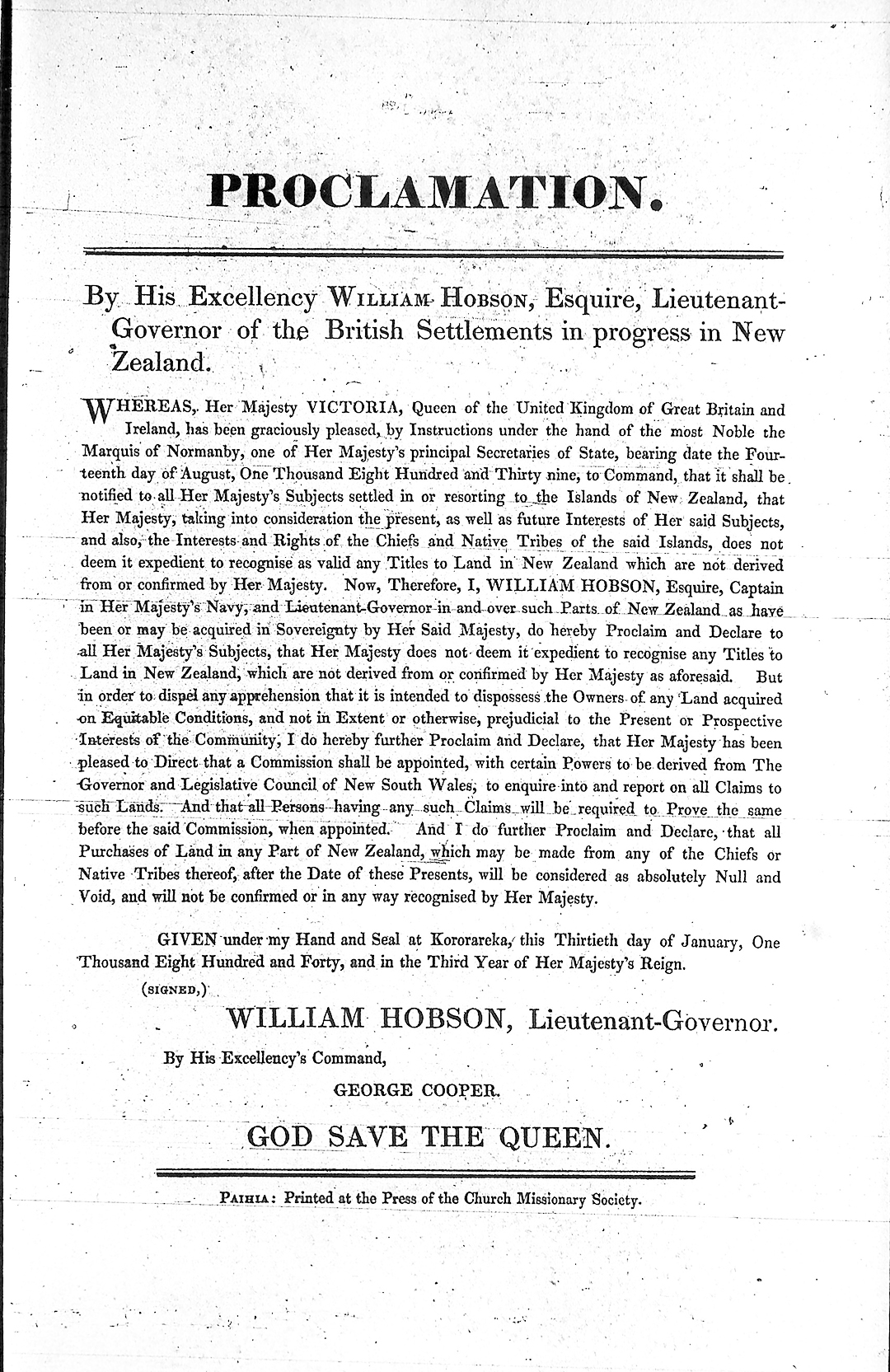
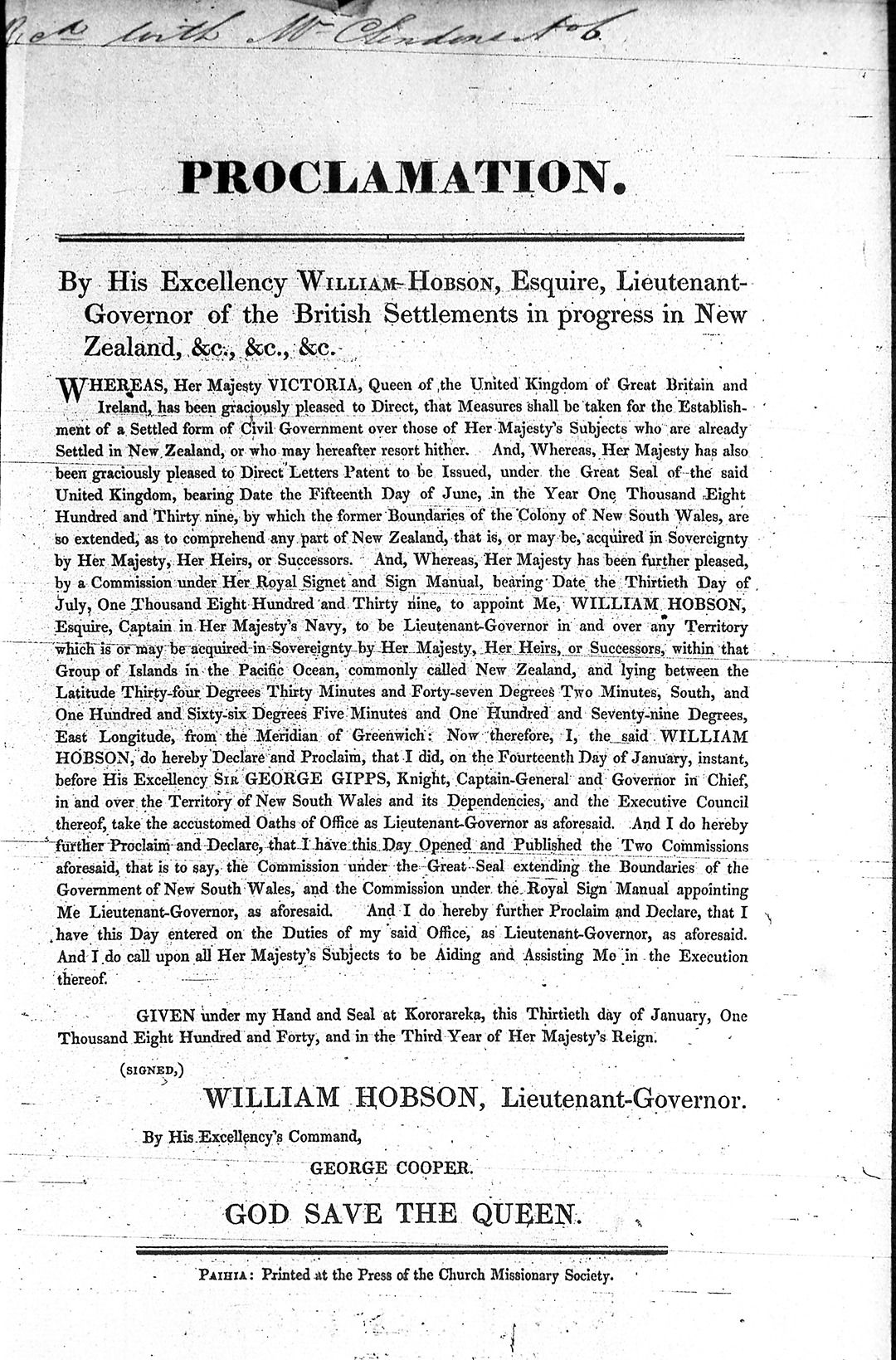
|
BUSBY’S FINAL DRAFT …4th of February 1840 Her Majesty Victoria, Queen of England in Her gracious consideration for the chiefs and people of New Zealand, and her desire to preserve to them their land and to maintain peace and order amongst them, has been pleased to appoint an officer to treat with them for the cession of the Sovreignty of their country and of the islands adjacent to the Queen. Seeing that many of Her Majesty’s subjects have already settled in the country and are constantly arriving; And that it is desirable for their protection as well as the protection of the natives to establish a government amongst them. Her Majesty has accordingly been pleased to appoint me William Hobson a captain in the Royal Navy to be Governor of such parts of New Zealand as may now or hereafter be ceided to her Majesty and proposes to the chiefs of the Confederation of the United Tribes of New Zealand and the other chiefs to agree to the following articles.- Article first The chiefs of the Confederation of the United Tribes and the other chiefs who have not joined the confederation, cede to the Queen of England for ever the entire Sovreignty of their country. Article second The Queen of England confirms and guarantees to the chiefs & tribes and to all the people of New Zealand the possession of their lands, dwellings and all their property. But the chiefs of the Confederation and the other chiefs grant to the chiefs Queen, the exclusive right of purchasing such land as the proprietors thereof may be disposed to sell at such prices as shall be agreed upon between them and the persons appointed by the Queen to purchase from them. Article Third In return for the cession of the Sovreignty to
the Queen, the people of New Zealand shall be protected by the Queen
of England and the rights and privileges of British subjects will
be granted to them.- Now we the chiefs of the Confederation of the United
tribes of New Zealand being assembled at Waitangi, and we the other
chiefs of New Zealand having understood the meaning of these articles,
accept of them and agree to them all. |
CLENDON’S DESPATCH... 20th of February 1840 Her Majesty Victoria, Queen of England in Her Gracious consideration for the Chiefs and the people of New Zealand, and her desire to preserve to them their Lands and to maintain peace and order amongst them, has been pleased to appoint an officer to treat with them for the cession of the Sovereignty of their Country and of the Islands adjacent, to the Queen - seeing that many of her Majesty’s subjects have already settled in the Country and are constantly arriving: And that it is desirable for their protection as well as the protection of the Natives, to establish a Government amongst them. Her Majesty has accordingly been pleased to appoint me William Hobson, a Captain in the Royal Navy to be Governor of such parts of New Zealand as may now or hereafter be ceded to Her Majesty and proposes to the Chiefs of the Confederation of United Tribes of New Zealand and the other Chiefs to agree to the following Articles. Article First The Chiefs of the Confederation of the United Tribes and the other Chiefs who have not joined the confederation, cede to the Queen of England for ever the entire Sovereignty of their country. Article Second The Queen of England confirms and guarantees to the chiefs and the Tribes and to all the people of New Zealand, the possession of their Lands, dwellings and all their property. But the Chiefs of the Confederation and the other Chiefs grant to the Queen, the exclusive rights of purchasing such Lands as the proprietors thereof may be disposed to sell at such prices as may be agreed upon between them and the person appointed by the Queen to purchase from them. Article Third In return for the cession of the Sovereignty to the Queen, the people of New Zealand shall be protected by the Queen of England and the rights and privileges of British subjects will be granted to them. signed, William Hobson Now we the Chiefs of the Confederation of the United Tribes of New Zealand assembled at Waitangi, and we the other tribes of New Zealand, having understood the meaning of these articles, accept of them and agree to them all. In witness whereof our Names or Marks are affixed. Done at Waitangi on the Sixth day of February in the year of our Lord one Thousand Eight Hundred and Forty. |
It can be readily seen that Clendon possessed the same text as Busby’s 4th of February 1840 English draft and sent it to the United States in his despatch No. 6.
As stated, Clendon’s English treaty version was penned on W. Tucker 1833 paper from exactly the same stock as Busby’s final English draft. Clendon had, obviously, transcribed his own copy of the developing final draft wording on February 4th, in anticipation of this despatch to the United States at a later date, should Hobson’s government be successful in securing a treaty.
Clendon’s despatch No. 6, complete with printed material from the C.M.S. Mission press, was very representative of similarly batched materials also sent to Britain and Australia in February by Hobson, as well as to the United States by Commodore Charles Wilkes in April 1840.
Letter text within the Wilkes’ despatch refers to the printed Proclamations and Treaty materials contained therein, some of which have survived within the U.S.S. Vincennes’ letter book records. Alternatively, the handwritten or printed Maori sheets and Proclamations sent in Hobson’s despatches to his superiors, were repatriated to New Zealand in the 1940’s and survive in pristine condition within the National Archives of New Zealand (see Vol. G - 30/1 or Vol. G - 36/1).
As stated, Clendon could not, on the 20th of February, guarantee that his English transcript version was still 100% officially precise down to the last “jot and tittle”, sufficient for a gazette notice in an American newspaper, so called it a ‘translation.’ Due to no English printed version becoming available on the 17th of February, when the Maori Tiriti O Waitangi was printed for official distribution, Clendon was obliged to write the temporary disclaimer to U.S. Secretary of State John Forsyth on the 20th of February:
‘This Translation is from the Native Document and is not a copy of the Official Document in English from which the Native One is made - and although the words may be different from what they were in the original I think the sense is much the same - but on the return to Capt. Hobson from the Southward I shall apply officially to him for a copy and translation of the Treaty for the purpose of sending it to the Government of the United States.’ (See despatch No. 6, Auckland Institute and Museum Library: Micro # 51. Despatches from the U.S. Consul to the Bay of Islands and Auckland, 1839-1906: Roll 1, May 27, 1839 - Nov. 30, 1846, also available at the University of Auckland Library).
So, what Clendon does not know for certain at that moment, he promises he will find out and, moreover, he will acquire the necessary goods directly from Hobson and send those "official" texts, both in English and Maori, to the Government of the United States. Hobson was away to the south at the time, aboard H.M.S. Herald.
- Clendon, in the cautious approach he took to stating the true position, further wrote that the transcript he was sending was not a copy of the "Official Document" in English from which the native one was made. In stating this he was absolutely correct. The official English document, or mother document from which Te Tiriti o Waitangi was derived, could only be the one that had survived the modifications of translator (Williams) in consultation with the legislator (Hobson).
All that Clendon had seen, advised concerning or transcribed was a "work in progress", nearing completion.
Reverend Henry Williams was not present when Clendon's transcription was made, but awaited Hobson and the draft at his CMS Mission residence, where Edward Williams was in attendance to assist. Further modifications to the text by Williams might well have been required.
- Reverend Williams had already stated to Hobson that if there was anything untranslatable in the draft he was given, then it would have to be ammended.
The task of translation was necessarily a difficult one, it being essential that there should be a complete avoidance of all expressions of the English for which there was no equivalent in Maori (see The Treaty of Waitangi, by T.L. Buick, pg. 113).
- An incident had also occurred at the treaty grounds on the sixth, wherein the Catholic Bishop, Pompallier, had interrupted the proceedings to ask for an added amendment. Busby records:,
'In the course of a few minutes the French Bishop attended by one of his priests, pushed forward to the side of Capt. Hobson & requested "That the natives might be informed that all who should join the Catholic religion should have protection of the British Government". Capt. H. with much blandness observed "most certainly" and expressed his regret that he had not made known his wish earlier as "Your desire should have been embodied in the Treaty" and turning to me requested that I would thus explain the wish of the Bishop. I observed to Cap. H. I presumed the same protection would be afforded to all. He said certainly. I asked what need of this announcement if all would have protection alike. Capt. H. observed that as the Bishop wished the communication to be made he should feel obliged by my delivering the same to the meeting...'
A written note guaranteeing general religious freedom was produced and shown to the Catholic Bishop, who said:
'Oh yes, that will do'.
This amendment or addition has sometimes been referred to as the 4th Article of the Treaty of Waitangi. Clendon, who, undoubtedly, witnessed this manoeuvre by Pompallier or heard about it later, would have been justified in assuming that the incident might lead to a modification of the treaty text.
As it turns out, the text was already all-encompassing enough to accommodate this belated (some say tactically and deliberately disruptive) request by the Catholic Bishop and didn't require any changes (See James Busby's Papers, Auckland Institute and Museum). Busby also mentions that: 'This account... was sent to the Editor of the Protestant Magazine and published in that periodical.'
- Clendon was correct in stating that:
'... the words may be different from what they were in the original but I think the sense is much the same.'
He needed to see the Hobson & Williams "final-final" to ascertain if that text varied in any degree to what he had transcribed at his home on the early afternoon of the 4th of February. Amongst other things, he needed to see if anything was added at the behest of Bishop Pompallier or changed by Reverend Williams.
Knowing by now that the treaty had been signed on the 6th of February, he could add that date to his transcript and despatch it as a reliable representation or translation of the treaty text in Maori, but would yet seek further documentation and clarification when Hobson returned from the 'Southward'.
- Clendon, in his very responsible position as U.S. Consul was utterly safe in calling his transcript a "Translation", for it did indeed convey the meaning of the Maori text accurately, and that was the primary objective of the preliminary intelligence contained within the despatch he was sending. At the same time, Clendon knew that he had only transcribed a "stage" of the draft as it neared completion. It still had to go yet further afield for final expert assessment by Reverend Henry Williams and there was a high likelihood that certain English words, phases and nuances would undergo change, by Williams, to achieve a precise translation into Maori of the original "meaning and tenor" that Hobson wished be conveyed.
Clendon was both a loyal Englishman and U.S. Consul at the same time and this position of split loyalties was the subject of some comment by Americans officials like Captain Charles Wilkes. Clendon had to maintain the dignity of his high office and preserve the amicable, co-operative relationships that existed between the British and American fleets in the region.
Lieutenant-Governor William Hobson showed all due respect for Clendon's official position and later made a special effort to supply Clendon with everything the U.S. Consul had officially requested. In doing so Hobson's Government observed proper diplomatic protocol in their dealings with the American Government.
Clendon was as good as his word and did apply ‘officially’ to the Hobson government for ‘a copy and translation of the Treaty for the purpose of sending it to the Government of the United States.’ Head Archivist of the National Archives, Kathryn Patterson, wrote the following to John Littlewood in October 1992:
‘The registers of letters received by the Colonial Secretary (held by National Archives) show Clendon requesting (and receiving) an official copy of the Treaty in March 1840. Unfortunately, Clendon’s memorandum does not say who provided him with the translation. We have had a search made of the Clendon manuscripts held in the Auckland Public Library to try to assist with this point, but to no avail’ (see Letter to John Littlewood from Kathryn Patterson, 12th of October 1992).*
*Footnote: At the bottom of Clendon's receipt letter of 25th March 1840, stating he had received the requested items from the NZ Government, we can see that he was directing his correspondence to Willoughby Shortland, Acting Colonial Secretary. By this time, Shortland also assumed the role of Acting Lieutenant-Governor, as Hobson was very ill and recuperating from his 1st of March paralysing stroke.
After sending his transcribed treaty version to the United States on the 20th of February 1840 Clendon made the official request to Hobson’s government for a ‘copy and translation’, just as he had promised the U.S. Secretary of State he would do. Sometime before the 18th of March the requested items were ‘placed in [his] hands’ by the Acting Colonial Secretary, Willoughby Shortland.
Clendon was now in a position to see exactly what the final English draft had settled-out to be. It had remained true to his own transcript, with no change.
Sovereignty of New Zealand was being ceded district-by-district
and it was unknown, in early 1840, just how much of the country would, ultimately,
become part of the British colony. The Americans, who had a thriving whaling
industry in New Zealand waters, needed to stay abreast of what treaties
were signed and districts ceded to ‘Her Britannic Majesty’.
This could decide which ports were visited for provisions and repairs, as
the whalers were averse to paying port fees or customs levies to the British
Government. Also, chiefs in certain districts might have entertained the
alternative prospect of joining the United States, which was a possibility
considered by Commodore, Charles Wilkes.
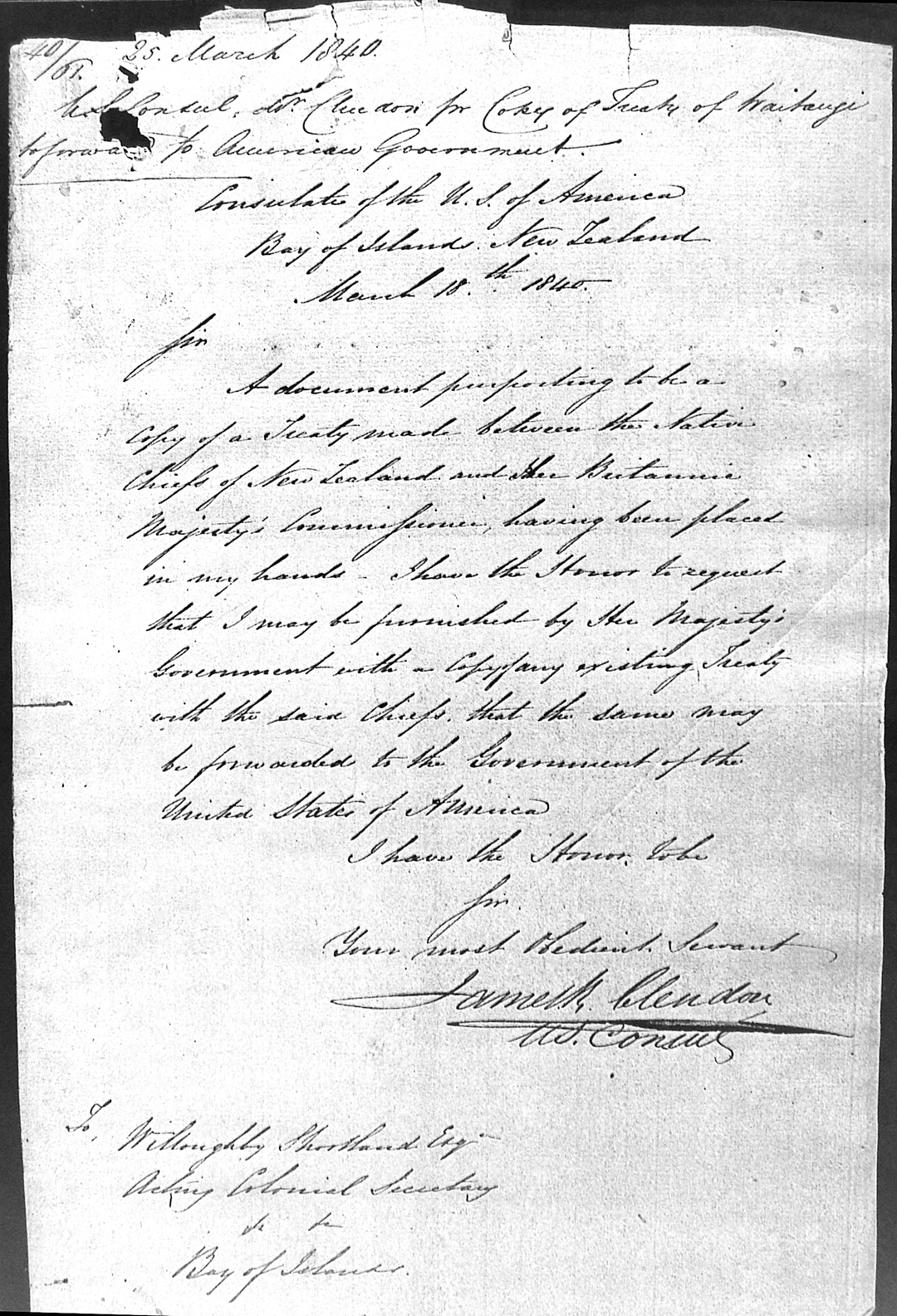
Clendon’s response to Willoughby Shortland, acknowledging receipt of the treaty documentation and requesting that he be kept informed regarding any further treaties entered into around New Zealand.
In the letter that Clendon wrote back to the Colonial Secretary he acknowledges receipt of the items he’d requested, but very formally requests to be kept informed about any and all treaties entered into. His letter to Colonial Secretary Shortland states:
‘A document purporting to be a copy of a treaty made between the native Chiefs of New Zealand and Her Britannic Majesty’s Commissioner, having been placed in my hands, I have the honour to request that I may be furnished by Her Majesty’s Government with a copy of any existing Treaty with the said chiefs, that the same may be forwarded to the Government of the United States of America’ (Alexander Turnbull Library qMS-1603). Underlining added.
Acquiring the Hobsom-Busby’s final draft document would have posed no problems for Clendon after Hobson returned paralysed to the Bay of Islands on March 6th. One can safely presume that it was left with the Colonial Secretary once Hobson knew Clendon needed it. Whereas Hobson had earlier rented Busby’s two-room cottage at Kororareka in anticipation of the arrival of his wife and children, his recent stroke had changed his plans dramatically. The two-room cottage became the permanent office of Willoughby Shortland, who wore several hats: as Acting Colonial Secretary, Police Magistrate and, now, Acting Lieutenant-Governor.
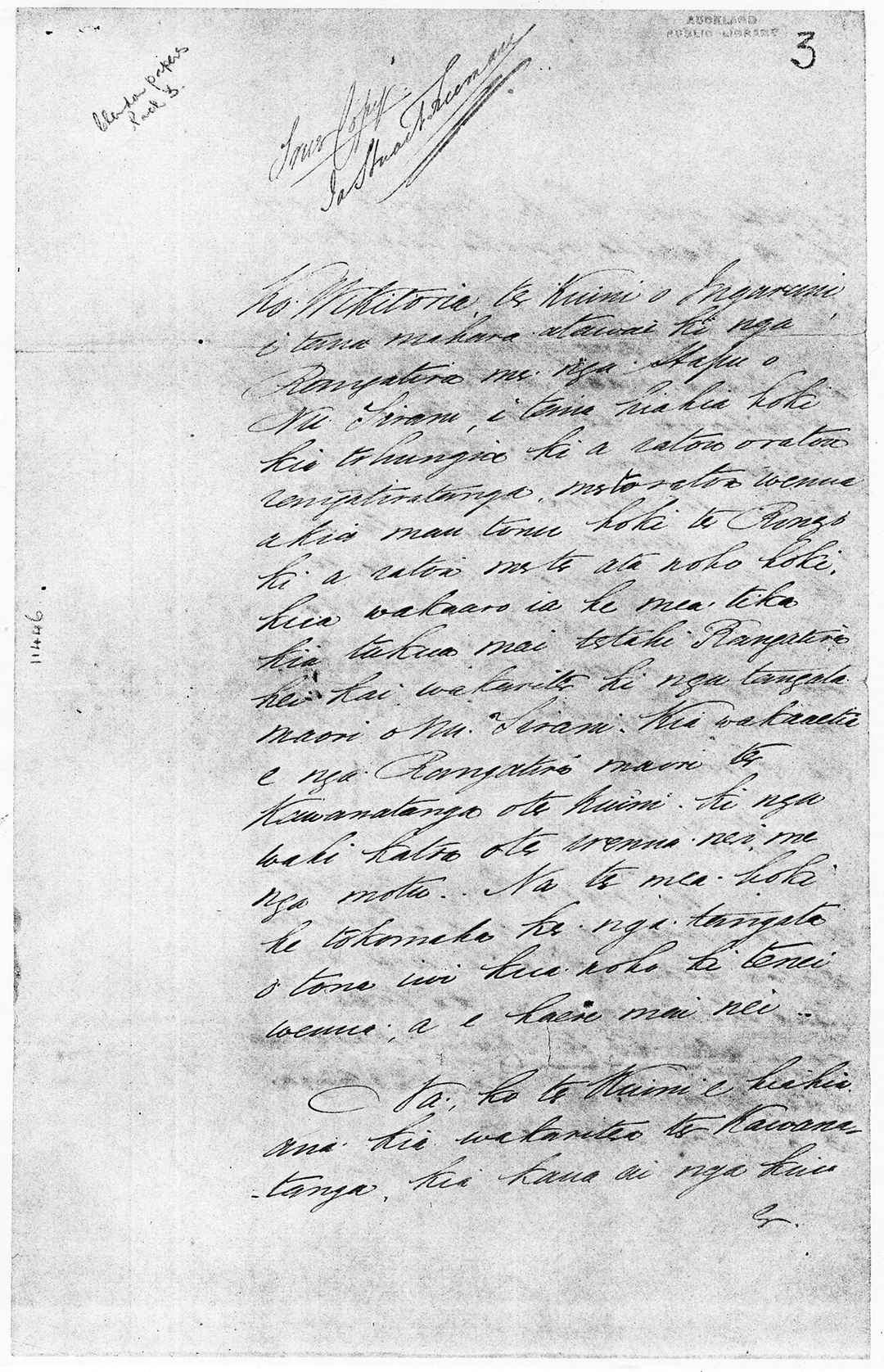
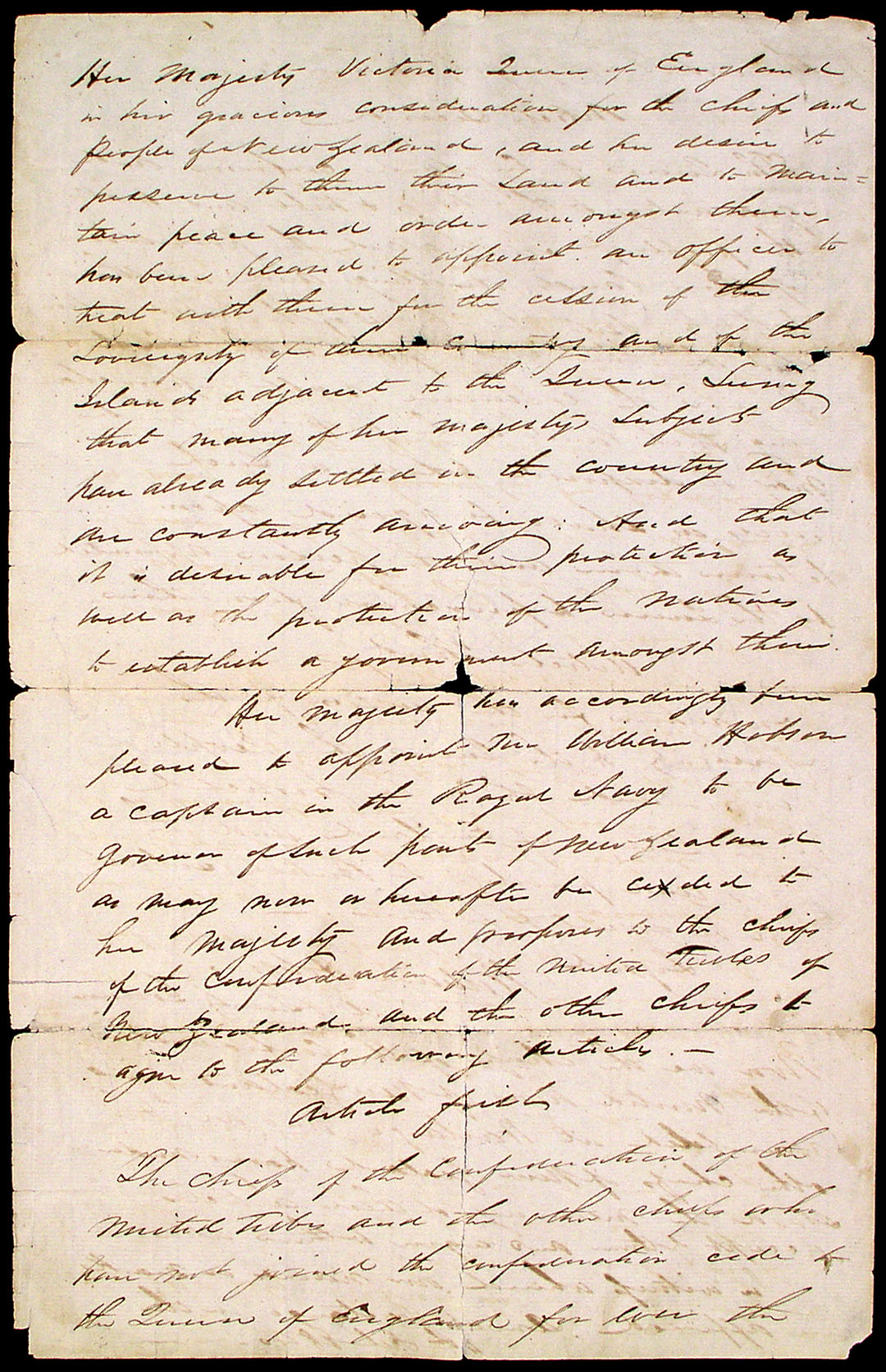
Some samples of what Clendon received from the Hobson government as per his official request. Above is seen part of a handwritten Maori text composed of 3-pages, in the handwriting of the official translator, Reverend Henry Williams and signed off by James Stuart Freeman, with the words “True Copy” above Freeman’s name. This handwritten, Maori language Tiriti letter-document still survives amongst the Clendon House Papers, Special Collections, Auckland Public Library.
Below that is seen Busby’s final English draft, Littlewood Treaty document, which came into Clendon’s possession before the 18th of March 1840 and remained with him for many years thereafter, until given to his solicitor, Henry Littlewood.
With receipt of these documents from Willoughby Shortland, Clendon had the “official treaty and translation” that he’d requested. He’d asked for nothing less than the official Maori & English texts. Busby’s handwritten, final English draft had been supplied, accompanied by a handwritten Maori text from Henry Williams, the official translator.